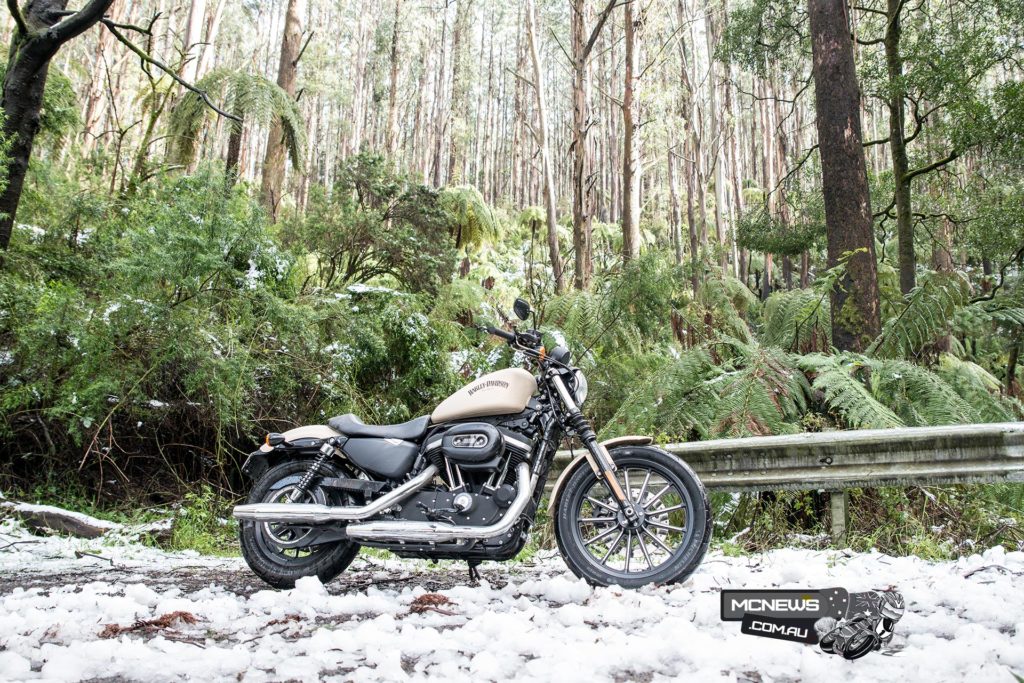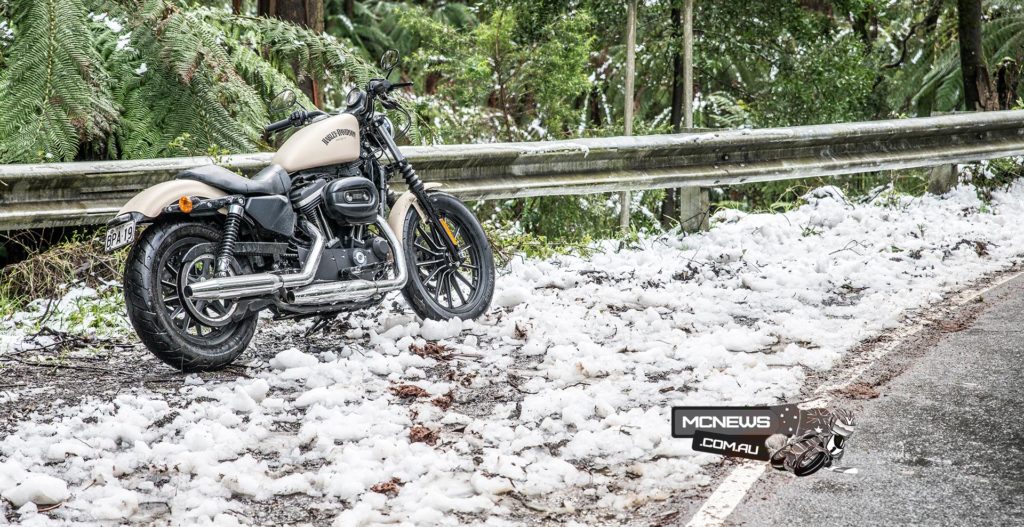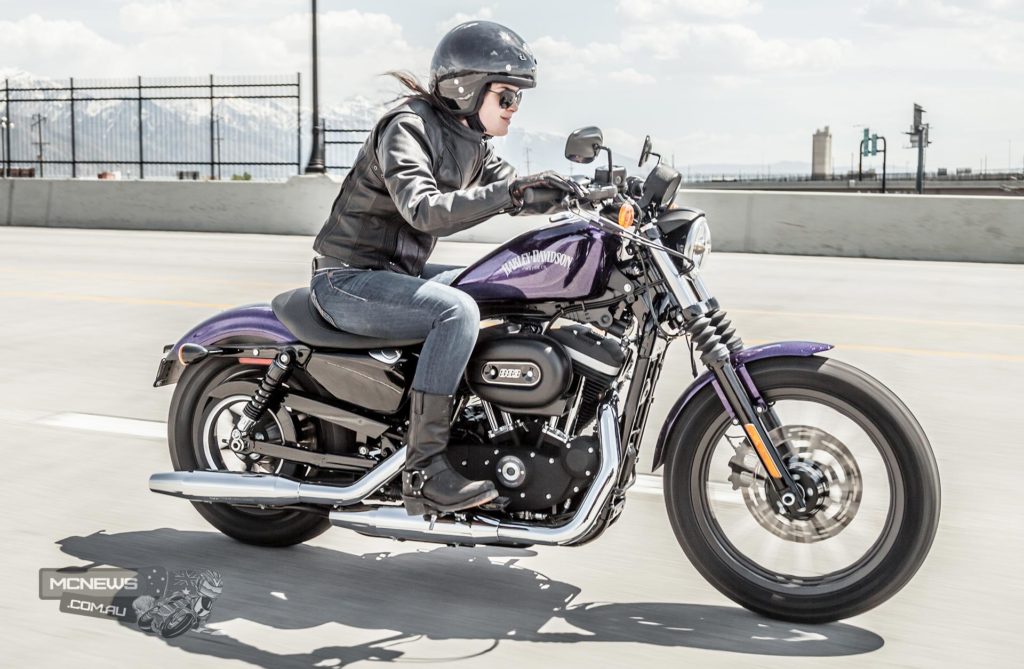Harley-Davidson XL883N Iron 883 Review – By Trevor Hedge
Harley-Davidson’s XL883N ‘Iron’ Sportster is the second most affordable machine in Harley-Davidson’s 32 model line-up. At $13,350 ($14,995 ride away) it is only fractionally undercut by the XL883L Superlow.
Climbing aboard any Sportster for the first time seems a strange experience due to the unusual placement of the mid-mount foot-pegs. At first, it feels plain wrong, but it doesn’t take long to adapt. I am 178cm tall and settled in after around 50km. If you are a long-legged six-foot plus, you might have a problem.
The bars on the Iron are what Harley call ‘slammed drag-style’, anyway after rolling your eyes at that one… they are actually quite a comfortable bend and place your arms at a fairly natural stance. Leave the pillion at home, the Iron sports no rear seat, although one can be optioned on to the machine if you so desire.
Firing up the engine requires no key, only to have the fob somewhere on your person. So just climb aboard, hit the start button and away you go. I like.
I must admit, that with the memory of previous Sportster models limitations in regards to rear suspension compliance, I had been fearing the worst for my coccyx on the mixed surfaces I planned to cover during my opening 150km sojourn from Ringwood to Eildon. But in fact, after that initial gambit I was ready for more and really, really, quite surprised at the amount of compliance Harley have managed to engineer into the rear end of the Iron. The well shaped and padded seat must play a part too but, to be honest, I would have never expected the Iron to ride as smoothly as it did with only a ridiculously short 41mm of rear suspension travel to play with. In fact, I still can’t get my head around it… Sure, it’s no magic carpet ride, but it certainly surpassed my, somewhat limited I must admit, expectations. However, add the optional passenger seat and extra human sat over the rear tyre and I would expect things to be far from accommodating.
Only the 1200cc ‘Seventy-Two’ can match the Iron for ground clearance, but the Iron’s slightly sportier size rims (19” F – 16” R), much sharper trail and slightly shorter wheelbase makes the XL883N Iron the clear leader in the Sportster handling stakes, particularly now that the XR1200 is missing from the Australia line-up.
The Iron does touch down a little earlier on right-handers due to the low-slung ‘staggered shorty’ exhaust but once you adapt your riding style the Iron can be a willing partner on a twisty road and offers the most lean angle of the Sportster range. It really does steer sweetly, I had quite a ball fanging up and down the Black Spur. The only Harley in the current range that would be as much fun in such environs is one of the V-Rod variants, but you can nearly buy two Iron 883s, one for you and one for the better half, for the price of a V-Rod. But of course the V-Rod does have that stonking Porsche developed motor to propel it from corner to corner…
In standard trim the 883 donk will power the Iron to 100km/h in under six-seconds and top out around 160km/h, if you hang on long enough. Good enough performance for most buyers of this style of machine. 110km/h is a comfortable enough cruising speed with the engine humming along smoothly at 3500rpm. And make no mistake, it is a very smooth running motor. Like all Harleys there is a fair shake at a standstill, but once up and rolling its smooth as silk, not even a minor blur through the reasonably useful mirrors.
The clutch is light and the five-speed gearbox works well enough. The Iron 883 is a doddle to manoeuvre around tight parking spaces or inner city laneways.
Fuel economy is a little over five-litres per 100km which gives the Iron 883 a range of approximately 230km if you’re game to run through to empty. Smarter to count on a safe 200km range between fills. I generally had the fuel light illuminate at around 165km to warn me of only three litres remaining.
Of course, with only 883cc to play with versus the 1202cc of its bigger Sportster siblings, or the huge 1690cc of the bigger Harley range, the Iron does miss a little of that heavy Harley crank feel at start-up, which admittedly is a big part of the theatre that Harley’s big twin brings to the show.
The 883 gives away 26Nm of torque to big brother. But, in fact, the crank is the same across both engine sizes, the 1200 sporting a 12.7mm larger bore to realise its capacity advantage. This also means that converting an 883 to a 1200 can be as simple as changing the pistons and barrels. Which on a Japanese four-cylinder might be a lot of work, but on a pushrod v-twin almost any engine work is a piece of cake, and surprisingly affordable. Servicing is reasonable too with the Iron only requiring workshop visits every 8000km which, along with self-adjusting hyrdaulic lifters doing away with the need for valve clearances, should ensure economical motorcycling. Not to mention the re-sale benefits that Harley ownership generally brings.
Take the almost $4000 you save buying the Iron over one of the 1200 Sportster range and you can make your own 1200 Iron, a model Harley-Davidson doesn’t offer, but we think they should!
We asked Harley Heaven to price up an 883 to 1200 cc conversion kit, and it is a lot more affordable than you might think. The street legal kit including pistons, rings, barrels, cylinder heads, gaskets, oil, filter, sundries, race tuning box and custom dyno tuning the quote comes to $3707.
Or if the full ADR compliance is something you can live without then you can also include hotter camshafts but retain the 883 heads, and ride out with a cammed-up big-bore 1200 for $3507. Tempting isn’t it… Keep the standard pistons and barrels as bar art… Then of course there are the intake and exhaust mods the machine really cries out for…
Harley’s Iron is quite the looker. Perhaps not quite as charming to the eye as the Forty-Eight, but perhaps a little tougher, and the Iron brings a lot more practicality to the table than that much more expensive machine. The Forty-Eight, like the Seventy-Two, makes do with a meagre 7.9 litre fuel tank to the Iron’s more useful 12.5 litres in its peanut shaped tank, neither of those aforementioned machines can hold a candle to the Iron in the handling stakes.
The instrumentation is elegantly simple but provides everything you need. The tripmeters, clock, gear position and rpm all shown on a very small LCD strip. Thanks to the positioning of the speedometer up nice and high it is all easy to read and the different functions can be scrolled through from the bar. Nice.
Braking performance has been improved for 2014 with new master cylinders, lever (non-adjustable), larger pistons in the calipers, new brake lines and larger rotors with the whole system managed by a new ABS system that works quite well.
An extra $1000 scores you the ‘Hard Candy’ paint but to my eye the Sand Cammo Denim we had on test strikes the best contrast to the all-black everything else. Only the tank and mudguards are coloured, elsewhere the Iron features more blacked-out components than any other Harley in production.
With a mild-steel frame and appendages Harleys generally take a little more looking after than most bikes in order to keep looking their best. Smart owners will keep a spray of WD or some grease on any places they find exposed threads, even the wheel bearing races quickly show signs of surface corrosion. Well, I guess, it is the Iron 883 rather than the Aluminium 883 after all…. But to my mind, that’s just not good enough, especially when Harley take so much care with all the fine details elsewhere on the bike that are finished so beautifully. The triple clamps, fork caps, rims and engine are all highly detailed to a great finish. The Iron might be almost the cheapest Harley, but in many areas I actually think it seems better finished than some of the bikes in the range costing almost twice as much. And there is certainly a lot less chrome to keep polished!
It is unfortunate that due to the 650cc capacity limit on learner machines the Iron is not learner legal. There are quite a few machines on the LAMS approved list that are faster than the Iron, and it certainly wouldn’t bust through the power-to-weight restrictions. Alas, learners will have to wait until the Street 500 arrives next year to get on a Milwaukee machine as their first ride. Hopefully that new model proves as good on the street as the Iron does, as to my mind the Iron 883 is my new favourite Harley, at least in comparison to any of the non-touring line up. For big days in the saddle there is no moving away from the Road Glide, Street Glide or Ultra Classic Electra Glide, but for shorter runs not too far outside city environs then the Iron 883 is my pick of the bunch, above the hugely popular Dyna and Softail models that dominate the sales charts. Unless I was spending someone else’s money of course, then it would have to be the CVO Road King…
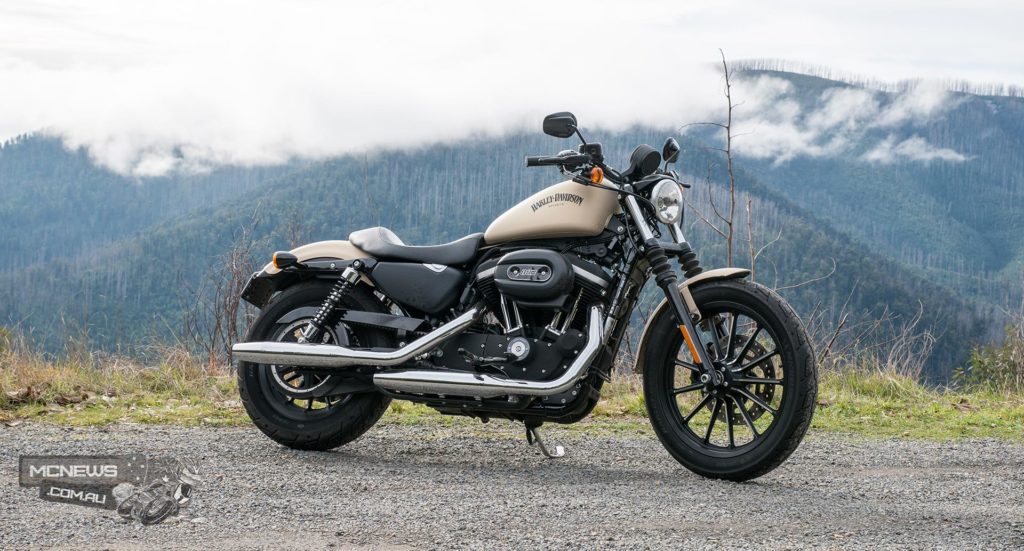
Specifications – Harley-Davidson XL883N Iron 883
- Engine – Air-cooled, Evolution, Pushrod, two-valves per cylinder, 883cc v-twin
- Claimed Torque – 71Nm @ 3500rpm (1200 has 97Nm – 1690cc has 138Nm – both at 3500pm)
- Bore x Stroke – 76.2mm x 96.8mm (1200 is 88.9 x 96.8mm – 1690 is 98.4 x 111.1mm)
- Compression Ratio – 9.0:1 (1200 is 10:1 – 1690 is 9.7:1)
- Fuel System – Electronic Sequential Port Fuel Injection
- Transmission – Five-speed, chain primary, belt secondary
- Chassis – Mild steel tubular frame, mild steel rectangular tube swingarm
- Forks – 39mm non-adjustable – 92mm travel
- Shocks – Twin coil-overs adjustable for preload only – 41mm travel
- Brakes – 300mm (F), 260mm (R), dual-piston calipers at both ends. ABS.
- L x W x H – 2255 x 855 x 1120mm
- Seat Height – 735mm
- Ground Clearance – 120mm
- Rake / Trail – 30.5 degrees / 117mm
- Wheelbase – 1510mm
- Weight – 245kg (dry)
- Tyres – Michelin Scorcher, 100/90-19 (F), 150/80-16 (R)
- RRP – $14,995 ride away
- Warranty – Two years, unlimited kilometres
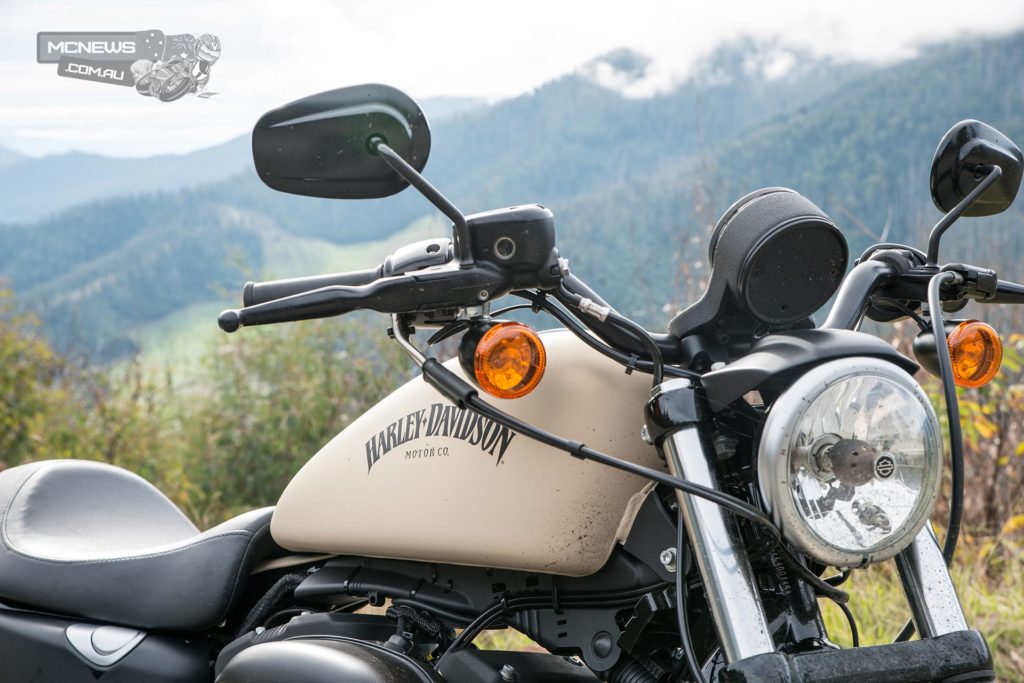
History – With 57 years in production, Harley’s Sportster line-up is one of the longest running lineages in motorcycle history. And one whose roots are still clearly visible in the profile of that original Ironhead 900, an engine that remained in production until the introduction of the Evo engine in 1986 which brought the first iteration of the 883cc donk. The early four-speed gearbox was replaced with a five-speed and a switch to belt drive in 1991. Further small improvements were made each year until the Sportster was essentially reinvented in 2004. A new frame, rubber mounts for the engine, improved gearbox and lots of other detail changes added up to a wholesale improvement of the model. Fuel injection arrived in 2007 and this year (2014) an all-new electrical system first seen on the big Harleys found its way in to the Sportster along with the convenient remote keyless ignition, larger brakes and ABS.
